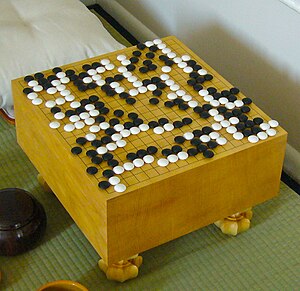Wei-Chi

Go is played on a grid of black lines (usually 19×19). Game pieces, called stones, are played on the lines' intersections.
|
|
| Years active | prior to Zhou dynasty (1046–256 BC) to present |
|---|---|
| Genre(s) |
Board game Abstract strategy game |
| Players | 2 |
| Setup time | Minimal |
| Playing time | Casual: 20–90 minutes Tournament: 1–6 hours |
| Random chance | None |
| Skill(s) required | Strategy, tactics, observation |
| Synonym(s) |
Igo / Paduk Baduk |
| a Some professional games exceed 16 hours and are played in sessions spread over two days. | |
| Go | |||||||||||||||||||||||||||||||||||
| Chinese name | |||||||||||||||||||||||||||||||||||
|---|---|---|---|---|---|---|---|---|---|---|---|---|---|---|---|---|---|---|---|---|---|---|---|---|---|---|---|---|---|---|---|---|---|---|---|
| Traditional Chinese | |||||||||||||||||||||||||||||||||||
| Simplified Chinese | |||||||||||||||||||||||||||||||||||
| Literal meaning | "encirclement board game" | ||||||||||||||||||||||||||||||||||
|
|||||||||||||||||||||||||||||||||||
| Korean name | |||||||||||||||||||||||||||||||||||
| Hangul | |||||||||||||||||||||||||||||||||||
|
|||||||||||||||||||||||||||||||||||
| Japanese name | |||||||||||||||||||||||||||||||||||
| Kanji | |||||||||||||||||||||||||||||||||||
|
|||||||||||||||||||||||||||||||||||
| Go | |||||||||
| Chinese name | |||||||||
|---|---|---|---|---|---|---|---|---|---|
| Simplified Chinese | 围棋 | ||||||||
| Traditional Chinese | 圍棋 | ||||||||
| Literal meaning | surround game | ||||||||
|
|||||||||
| Tibetan name | |||||||||
| Tibetan | མིག་མངས | ||||||||
|
|||||||||
| Korean name | |||||||||
| Hangul | 바둑 | ||||||||
|
|||||||||
| Japanese name | |||||||||
| Kanji | 碁, 囲碁 ("surround game") | ||||||||
|
|||||||||
Go is an abstract strategy board game for two players, in which the aim is to surround more territory than the opponent.
The game was invented in ancient China more than 2,500 years ago and is believed to be the oldest board game continuously played today. It was considered one of the four essential arts of the cultured Chinese scholars in antiquity. The earliest written reference to the game is generally recognized as the historical annal Zuo Zhuan (c. 4th century BC).
Despite its relatively simple rules, Go is very complex. Compared to chess, Go has both a larger board with more scope for play and longer games, and, on average, many more alternatives to consider per move. The lower bound on the number of legal board positions in Go has been estimated to be 2 x 10170.
The playing pieces are called "stones". One player uses the white stones and the other, black. The players take turns placing the stones on the vacant intersections ("points") of a board with a 19×19 grid of lines. Beginners often play on smaller 9×9 and 13×13 boards, and archaeological evidence shows that the game was played in earlier centuries on a board with a 17×17 grid. However, boards with a 19×19 grid had become standard by the time the game had reached Korea in the 5th century CE and later Japan in the 7th century CE.
Once placed on the board, stones may not be moved, but stones are removed from the board when "captured". Capture happens when a stone or group of stones is surrounded by opposing stones on all orthogonally-adjacent points. The game proceeds until neither player wishes to make another move; the game has no set ending conditions beyond this. When a game concludes, the territory is counted along with captured stones and komi (points added to the score of the player with the white stones as compensation for playing second, which is normally either 6.5 or 7.5 depending on the rule-set being used) to determine the winner. Games may also be terminated by resignation.
...
Wikipedia
